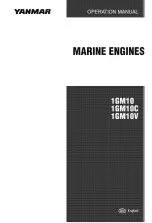
Engine Overhaul Manual
Jabiru Aircraft
Pty Ltd
Jabiru 2200 & 3300 Aircraft Engines
This document is controlled while it remains on the Jabiru server. Once this no longer applies the document becomes uncontrolled.
ISSUE
1
2
3
4
5
6 7
Dated : 28/10/2014
Issued By: AS
Page: 58 of 201
L:\files\Manuals_For_Products\Engine_Manuals\Overhaul_Manual\JEM0001-7_Overhaul_Manual_DRAFT_(29_10_14).docx
5.8.6 Magnetic particle inspection (MPI)
All steel parts should be inspected by the magnetic particle inspection (MPI) method. The successful
detection of structural failure by magnetic particle inspection demands skill and experience on the part
of operating personnel.
Too rigid an interpretation may result in the rejection of a sound part, while on the other hand, a part
showing a dangerous indication may be returned to service as a result of a too casual diagnosis. In
general, areas of stress concentration must be watched closely for fatigue cracks. These areas include
such locations as keyways, radii in the corners of the crankshaft, gear teeth, small holes and fillets.
5.8.7 Damaged parts
Abnormal damage such as burrs, nicks, scratches, scoring, or galling should be removed with a fine oil
stone, crocus cloth, or any similar mildly abrasive substance.
If scratches or galling are removed from a bearing surface of a journal it should be buffed to a high
finish with a linishing wheel.
Flanged surfaces that are bent, warped, or nicked may be repaired by lapping to a true surface on a
surface plate. Again the part should be cleaned to be certain that all abrasive has been removed. Pipe
tapped threads (NPT) must not be tapped deeper in order to clean them up, because this practice will
invariably result in an oversized tapped hole.
Following any repairs of this type, the part should be carefully cleaned in order to be certain that all
abrasive has been removed and then checked with its mating part to assure that the clearances do not
exceed those detailed in the Table of Limits.
5.8.8 Replacement of studs or broken cap screws
The method of removing studs or broken cap screws depends on the type of stud or cap screw and if it
is intact or broken.
The procedure for removing studs or broken cap screws is as follows:
1. If there is sufficient thread area available on the stud, use a collet grip tool consisting of a tapered
collet that threads onto the stud and a housing that slips over the collet as shown at right.
Tighten the bolt on top of the housing and draw the collet into the housing to load the puller onto the
stud with a tight grip. Withdraw the stud by turning the housing. Heat may be required to loosen the
Loctite.
2. If a cap screw or stud is broken and there is not enough thread exposed to use the collet type tool,
drill a small hole into the stud using a high-performance drill bit such as a cobalt high speed bit. Use
a pilot bushing to guide the drill into the centre of the stud if it is broken close to or beneath the
surface of the parent metal. Redrill and enlarge the hole to suit the proper size extractor, shown in
Figure 62. Using the extractor, remove the stud. Again, heat may be required to loosen the
Locktite. The RIDGID extractor is available from Ridge Tool Co. of Elyria, Ohio, USA or most tool
suppliers. It is a very effective tool and the only screw extractor recommended by Jabiru Aircraft.
Figure 62
– Stud & Broken Cap Screw Removal
















































